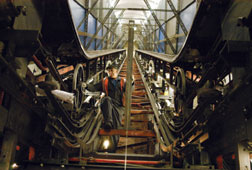...which is quite distinct from an operational phase....[Here], from day one, we had an operating company.”
Tube Lines has undergone significant changes in shareholders. Amey was acquired by Spain’s Ferrovial Group. Last year, Ferrovial raised its Tube Lines stake to two thirds by buying-out Jarvis Group.
“One of the things we have tried to develop since day one was...a culture for Tube Lines itself,” says Hurrell. Nevertheless, “It’s not an integrated model between the shareholders,” he adds. “The main [collaboration] route is through [secondary] agreements.”
Under these agreements, Bechtel provides senior managers for new works while Amey does the same for maintenance. The agreements set out how LUL’s performance-related bonuses or penalties are shared among consortium members.
Otherwise, shareholders have no rights to Tube Lines’ contracts, says Hurrell. “If a shareholder wanted to participate [in a contract], it would be through competitive tender,” he explains. Independently of the Amey and Bechtel-led teams, a Tube Lines planning unit ensures “we deliver all our contractual obligations,” says Hurrell. This interfacing team also looks for efficiency improvements.
“We had a very good solution to package the work into smaller contracts that would attract a great deal of market interest...and better pricing,” says Adams. “We are following the strategy we set at the outset, and it’s working well.”
 Tube Lines Escalators get makeover.
|
Tube Lines continues to follow its overall strategy, but has been revising its tactics. For track and station work on each of its Jubilee, Northern and Piccadilly routes, Tube Lines inherited contracts based on a “loose partnership agreement” with designers and contractors, says Amjad Bangash, Tube Line’s delivery manager for stations.
Such partnering had become widely popular in civil projects and LUL was among the U.K.’s leading exponents, says Andy Mitchell, the owner’s PPP contract director for Tube Lines’ share of the system. But it was not working. “All the risks were ours....We couldn’t control the costs,” says Bangash.
To improve control, “we went the lump-sum route for the next [10] stations,” with Tube Lines doing more design, says Bangash. But that approach also was flawed. “When you work in a lump-sum environment and you have...many changes, the contract becomes all about change management rather than managing the job,” he says.
For the third wave of 16 stations, Tube Lines continued with CM for six but became construction manager/general contractor for the rest. That involved boosting staffing from about 380 to 450, redeploying people becoming available from early track work.
Using labor suppliers, Tube Lines now directly manages preparatory work ahead of speciality contractors. “By then, a lot of the risk is done,” says Bangash. Production is much improved, he adds, but “there’s room to grow.” From LUL’s perspective, the new strategy “has had its difficulties, but it has worked well,” says Mitchell.
Tube Lines has completed nearly half of the 97 stations it must improve by 2010. Stations have been “an area where the agreement of scope [with LUL] was a challenge,” says Hurrell. “We just found it important to keep the process in the stations moving rather than pausing...to agree on things in absolute detail”.
The conditions of stations vary dramatically from line to line, calling for diverse treatments and specifications. Some stations, considered architecturally valuable, are legally protected. They require special approval from the local authority before remodeling can begin
For Metronet, agreeing on scope of station work with LUL quickly became a growing problem. “Pricing had to be based on a high degree of extrapolation...particularly in things like stations,” says Metronet’s source. With such a big, lengthy project, detailed costs were unknowable, he adds. “The whole thing was set up by central government and then passed to [LUL],” he says. As a result, there was an element of retrospective scope setting, he claims
By 2005, Metronet’s owners started writing off potential losses because of delays and cost overruns. Last year, Metronet’s credit worthiness on over $2.5 billion of loans and bonds was lowered by a leading rating agency.
 |
"The contract becomes all about change management rather than ...the job." — Amjad Bangash
|
“The fundamental difficulty, which caught us by surprise...is the amount of unforeseen changes. When we got into it. it was radically different [and] that suited the Tube Lines model,” says the Metronet source.
Metronet late last year began emulating Tube Lines by soliciting bids for contracts outside its own supply chain. This February, it announced the first six external contracts for station upgrades, together worth $300 million and promised to extend outsourcing further. But it was too late, believes Zuk. Unbundling its procurement arrangements in time while maintaining site progress was beyond Metronet’s reach, he explains.
In June, Metronet called in the contract’s arbiter, claiming around $2 billion of extra costs on just one of its contracts. It sought about half the money in an urgent interim payment. When the arbiter allowed only a fraction of that sum, Metronet folded.
“Most colossal failures occur when you fail to pay attention to the most basic principles,” says Zuk. “That’s what happened to Metronet.” With Tube Lines and Metronet doing similar work, “the difference is [the] planning and execution in virtually every respect”.
Looking back on the events, the pitfalls now are clearly visible to the Metronet source. But amid all the contract’s complexity, they were missed by executives employed by some of the world’s biggest and most experienced infrastructure firms.
At the time of structuring the deal, “there were a hundred things we were [also] concerned about,” says the Metronet source. “Could we have predicted it? That’s quite a tough call.”

Post a comment to this article
Report Abusive Comment